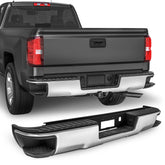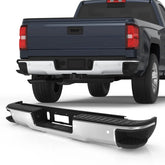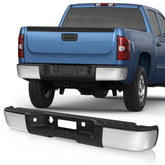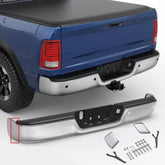Clean chrome bumpers: All you need to know
As beautiful as it is fragile, chrome needs special care. On a car, chrome parts are often put to the test, and scratches can easily occur. Chrome is a metal. While it provides a beautiful finish, it requires special care to enhance the object to which it is electroplated.
What is chrome?
Chromium is a soft metal. It is not used to make objects, but rather in alloys or as a thin layer on an object to protect it from corrosion and give it a beautiful bluish sheen. It can be found everywhere from bathroom and kitchen faucets to wheel rims, bumper guards and saucepans. Although chrome is tough, it needs to be polished regularly. Be aware that using the wrong product on chrome can scratch it, or worse, remove it completely.
The benefits of chrome on cars
If there's one industry where chrome is ubiquitous, it's the automotive industry. This material is valued for the shiny finish it gives to metal parts, but more importantly for its high resistance to corrosion. To take advantage of chrome's virtues, specialists use the chrome plating technique, which comes in two types: decorative chrome plating and thick, hard chrome plating. Decorative chrome plating is widely used in the automotive industry, for example, to make bumpers, mirrors, and rims. It is also used for technical and telephone equipment, precision, optical and medical instruments, household appliances, etc.

This technique provides tarnish resistance, surface hardness and passivity. However, in addition to chromium, it requires the use of nickel, which is non-porous, ductile, and thick. Thick, hard chromium plating, on the other hand, is more commonly used in mechanical applications subject to high friction. It has non-stick properties, low friction consistency, and load bearing qualities. It is resistant to corrosion, high hardness and wear.
How to remove rust from chrome bumper one?
Step 1 - Aluminum foil
Small rust spots or tiny areas of oxidation look very unsightly, so the easiest way to remove them is with aluminum foil. Take some aluminum foil and roll it into a large ball. Don't roll it too tightly. When you've got a good ball shape, gently roll it between your hands to even it out.
Step 2 - The Coke
Pour a substantial amount of the cola into the bowl. Dip the aluminum foil ball into the bowl of cola and rub vigorously over the area of the chrome that has rust stains. Work in small areas first, no more than 6-8 inches, and then work thoroughly. Soak the aluminum foil for the cola each time so that it is generously coated.
Step 3 - Rubbing
Rub the foil into the chrome until you see that the rust spots are almost gone. You should really see them start to dissolve as you move the blade back and forth. Then dip it back into the cola and rub vigorously again. Eventually the stains should disappear. This method has been tried and tested by many people and found to be one of the most reliable ways to remove rust stains from a chrome bumper.

Step 4 - Cleaning
Once you've removed all the small rust stains from the chrome, use a clean cloth dampened with warm water to wipe the Coke off the chrome and remove the sticky film it leaves behind. Then wipe and dry with a clean, lint-free cloth. If you're still left with some stains, you can repeat the process until you're happy with the results.
Step 5 - Large areas of rust
This requires a more robust approach. Use steel wool with a good amount of chrome cleaner and polish. Although slightly abrasive, steel wool has a slightly gentler effect on chrome than using sandpaper or a more abrasive form of material.
Step 6 - Chrome Polishing
Rub the chrome cleaner into the rusty chrome area with the wire wool, using gentle circular movements rather than the wood planing technique. Be careful how you rub the wire wool and be careful not to create tiny scratches on the surface of any unmarked chrome.
Step 7 - Polishing
Once you've removed the rust stain, you're ready to polish and buff the chrome with a good pad.
How to repair scratches in chrome bumpers?
Chrome bumpers have been used on cars and trucks for years and are especially common on classic and vintage vehicles. Because of their vulnerable location at the ends of a vehicle, they can be easily damaged by rocks and debris thrown up from the road. Chrome bumpers often develop small scratches. These can be removed with a little effort and the right tools.
Wash the bumper with a mild detergent such as dish soap. Rinse the bumper with a hose, then dry it thoroughly with a clean, dry, lint-free towel.

Polish the bumper with a good quality chrome polish. Apply a small amount of polish to a microfiber cloth and wipe over the chrome. Work the polish into the scratch, then buff out the polish.
Finish removing scratches with the finest quality steel wool. Wet the bumper with water to avoid dulling the surface when using steel wool. Apply a small amount of paint to the steel wool, then work it into the scratches, buffing gently as you go. Be sure to keep the surface wet to avoid scratching the chrome.
Rinse the bumper thoroughly with water, then dry with a clean, dry microfiber cloth.
What not to do when cleaning chrome!
If you're new to cleaning chrome, avoid scraping with a hard metal tool. You run the risk of scratching the chrome, or worse, removing the chrome completely and leaving the part bare.
Scratched chrome can be restored with a polish, but a part that has been stripped, even partially, is not easily restored. You have to reapply chrome or "repaint" the damaged areas with silver paint, which is quite expensive.
Featured Products
- $299.99
$359.99- $299.99
- Unit price
- / per
- $289.99
$368.99- $289.99
- Unit price
- / per
- $294.99
- $294.99
- Unit price
- / per
- $279.99
- $279.99
- Unit price
- / per














